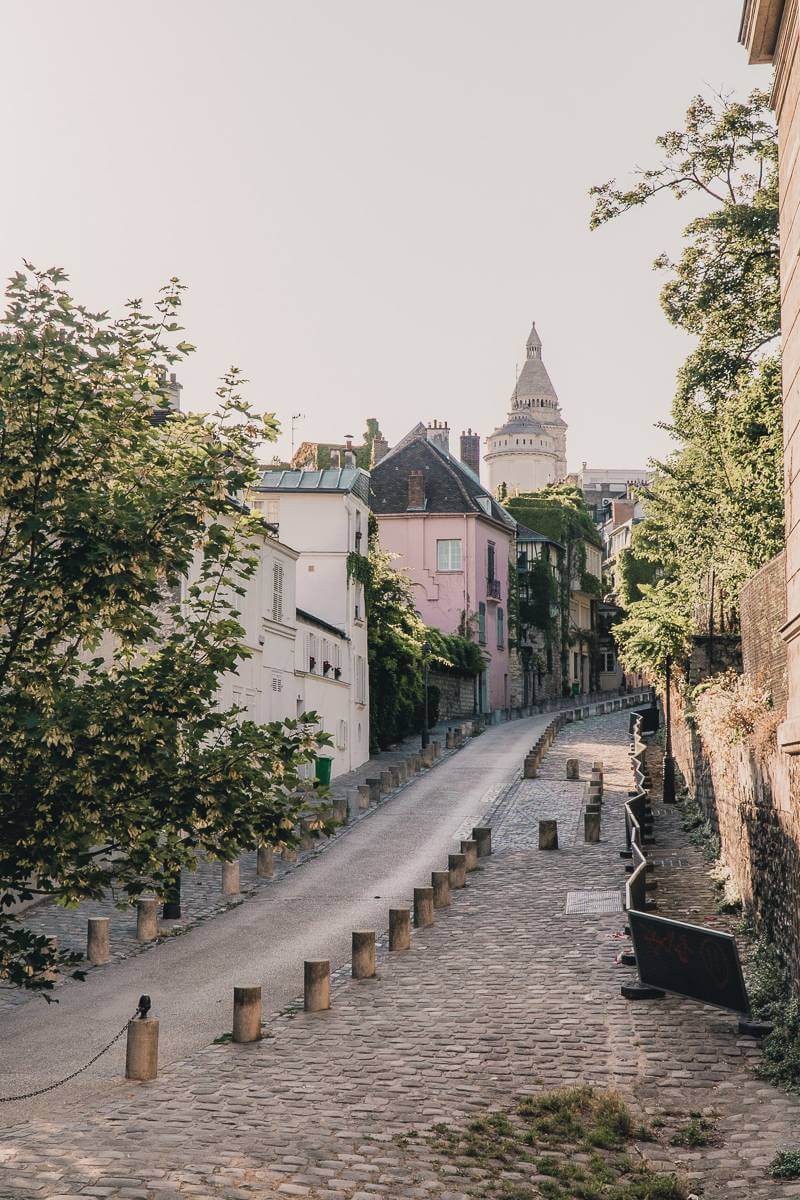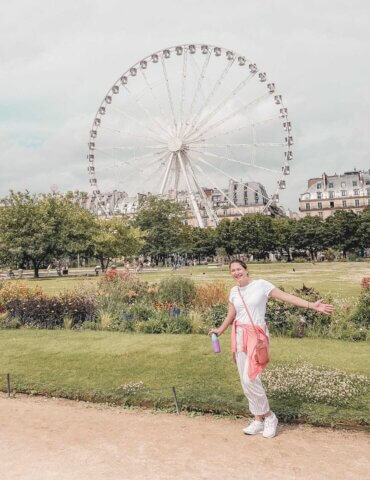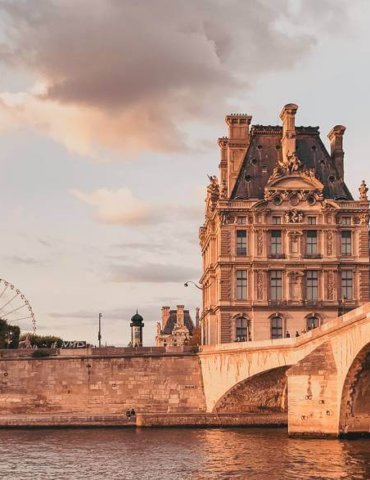This post may contain affiliate links, meaning if you buy or book through one of these links, I may earn a small commission .
If you are looking for the ultimate charming walk through Paris, look no further than Montmartre in the 18th arrondissement. Located on top of the “butte”, or hill, Montmartre boasts the iconic white basilica of Sacré-Coeur, and was once home to artists like Renoir and Picasso. Below, I’ve created a stunning walk through Montmartre to make sure you see its most beautiful and inspirational scenery.
On my first ever two-day trip to Paris, I actually skipped Montmartre, and had no idea what I was missing! This neighborhood used to be its own village outside of Paris until 1860, and retains a bohemian spirit and energy. Starting in the mid-1800’s, Montmartre’s cheap rents attracted all types of artists, and their creative energy still permeates in the cobblestones today.
As Montmartre sits on the butte, any visit to the 18th arrondissement will include some stairs and inclines. During my recent solo Paris trip, I kept returning to Montmartre, heaving myself up the hill and dripping in sweat. However, I’d always sigh at the beauty that greeted me at the top, which is ultimately what inspired me to share this dreamy Montmartre walk.
18 Stops for the Most Magical Montmartre Photo Walk
Below is a mapped route of this photo walk, and underneath, I am listing out the sights in the order that you’d find them. Of course, you can do this walk in any order you want, but the suggested route will ensure you don’t miss any Montmartre highlights.
If arriving by metro, I recommend taking the green line to the Abbesses stop (be ready for stairs!). I’ve also created a map with pins of all the below sights here.
It’s best to do this self-guided Montmartre walk in the morning. By afternoon, the area will be crowded with tourists, crawling with pick pocketers, and in peak summer, insufferably hot. I should know – the high was 106 degrees F during my visit!
Wall of Love
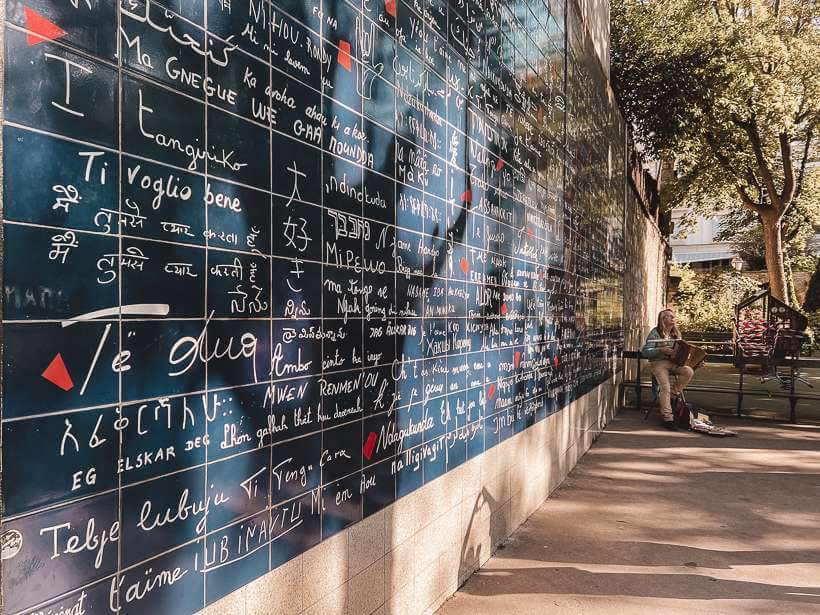
The Wall of Love, or Le Mur des Je t’aime, is one of the first sights you’ll encounter upon climbing the hill into Montmartre. It is located inside a darling little park on Place des Abbesses. The wall is a popular photo spot, and you will see many visitors posing for selfies.
The wall consists of 612 squares made of enamelled lava, with “I love you” written on them 311 times in 250 languages. Designers Frédéric Baron and Claire Kito also scattered little red shapes among the words to represent a broken heart from the separation of mankind. The wall itself optimistically symbolizes a reunification.
During my visit, a man sat in front of the wall signing songs of heartbreak while playing the accordion. “Jamais, jamais, jamais” repeated in my head for the rest of the morning.
Le Bateau-Lavoir

Le Bateau-Lavoir (translation is “laundry boat”), is the artists’ studio on Place Émile Goudeau where Picasso once lived and worked. Here, Picasso painted works from his Rose Period, which are thought to be inspired by model Fernande Olivier. In 1907, he painted Les Demoiselles d’Avignon, thus beginning his famous cubist style.
The current Bateau-Lavoir building is not the original, as the studio burned down in 1970. However, the reconstructed space still functions as a studio today for budding artists.
As the studio is closed to the public, you can only view the exterior, which unassumingly sits in a shady corner of the square. It’s easy to miss if you aren’t looking for it!
Note: Before continuing your Montmartre walk, stop at the Wallace Fountain in the square. It’s the perfect chance to top off your water bottle for free!
Dalida Statue

Dalida was a French singer who saw great career success, with songs like “Paroles paroles” and “Bambino”. Raised in Egypt by Italian parents, Dalida came to Paris during the 1950’s to launch her career. In 1962, she purchased an apartment in Montmartre at 11 rue d’Orchampt. You can still view its little balcony today.
Although Dalida is a celebrated musician and known for fun disco songs, she struggled personally. Sadly, the singer took her own life in her Montmartre home in 1987 at the age of 54.
In 1997, Dalida was immortalized with a bust facing up towards Rue de l’Abreuvoir, one of Paris’s most picturesque streets. Strangely, rubbing the singer’s bosom is said to bring good luck. You can see from the wear on the statue that she has received a lot of superstitious visitors!
It is also possible to pay homage to Dalida by visiting her grave in Montmartre Cemetery.
Rue de l’Abreuvoir
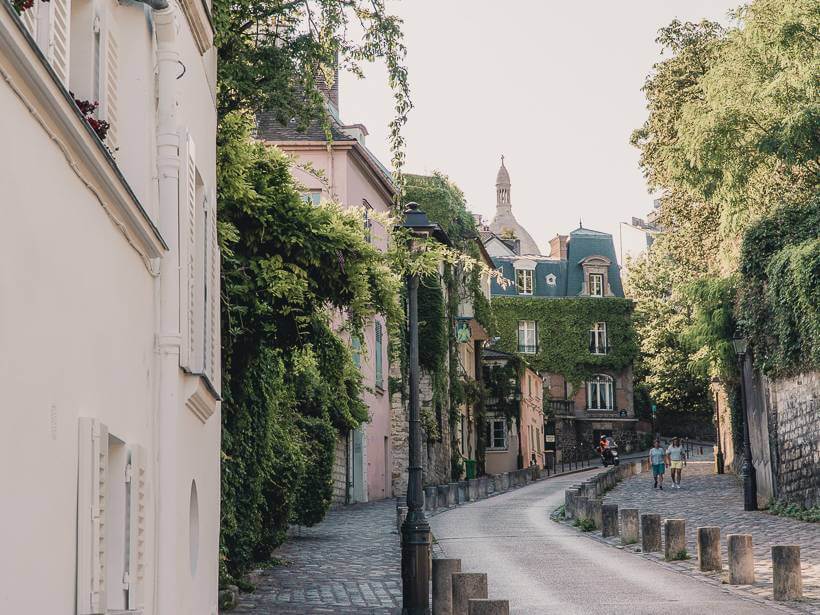
Turn opposite from the Dalida statue, and you’ll be looking up Rue de l’Abreuvoir. If you feel yourself swooning, that’s totally normal…with the dome of Sacré-Coeur rising above the pretty houses, it’s a beauty! Reference was made to the street as early as the year 1325, when it was called “Ruelle qui va au But”.
You may also know this street from the scene in Emily in Paris, where Emily stages a bed at the bottom of the hill during a marketing campaign. Emily’s friend, Mindy, translates the street’s earlier name to “road that leads to the end”. However, I think it means something closer to “alley that leads to the top of the hill”.
Chemin de L’Abreuvoir became the street name in 1863. “Abreuvoir” means “trough”, which refers to the drinking trough that once sat at the corner of Rue Girardon and Rue de l’Abreuvoir.
The street stretches from Place Dalida to Rue des Saules, which is where this Montmartre walk is heading next. Don’t forget to take photos along the way!
La Maison Rose
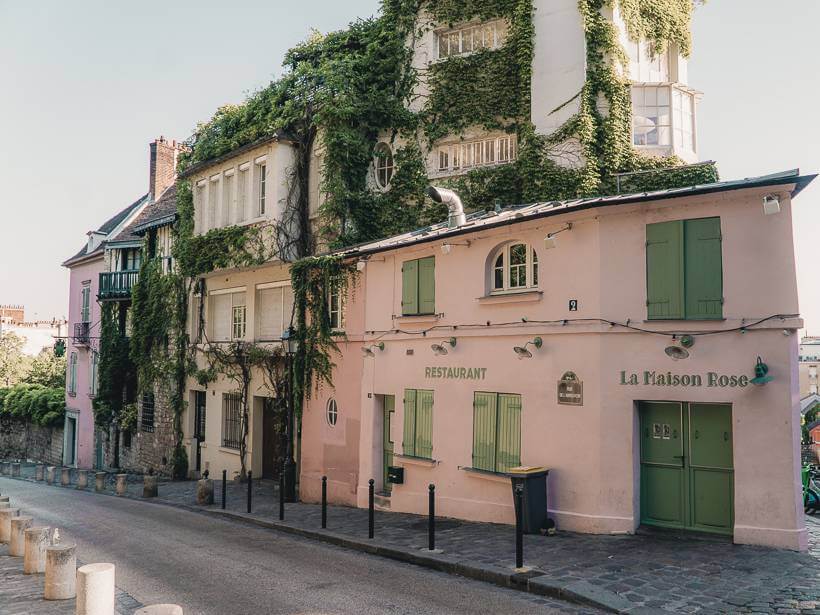
La Maison Rose, with its famous pink façade, sits sharply on the corner of Rue de l’Abreuvoir and Rue des Saules. Germaine Gargallo, wife of painter Ramon Pichot, opened the restaurant in 1908. It quickly became a regular hangout for various artists and their friends.
Maurice Utrillo was the one who immortalized La Maison Rose in his paintings, although he was greatly influenced by Élisée Maclet, who painted the same scenery before him. The restaurant changed hands over the years, while the likes of Dalida and Albert Camus dined here and furthered the restaurant’s legendary status.
Visitors can still eat and sip a coffee at this café while visiting Montmartre today. For the best photos of La Maison Rose, come early in the morning, when you’ll have the place mostly to yourself. By the afternoon, this popular spot will be overrun with selfie-takers.
Rue Cortot
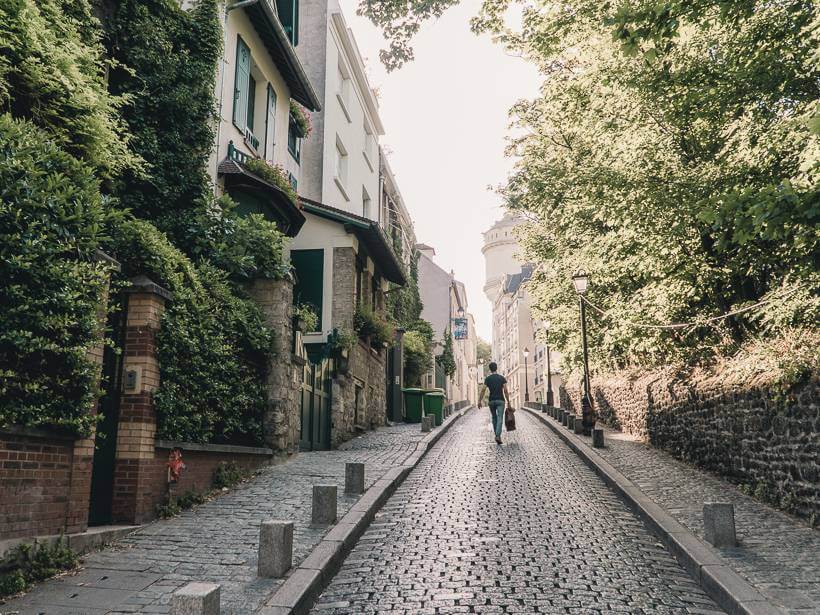
You’ll encounter shady Rue Cortot after crossing Rue des Saulles in front of La Maison Rose. Straight ahead, you’ll see the Montmartre water tower, which uses the same stone as Sacré-Coeur and still services Montmartre buildings at the top of the hill today.
Formerly called Rue Saint-Jean, the street first appeared on a Paris map in 1672. The new name took place when Paris acquired the village of Montmartre in 1860, naming it after sculptor Jean-Pierre Cortot.
Number 6 was once home to landscape and portrait painter Adolphe-Felix Cals, who lived there until 1853. Later, composer and writer Erik Satie lived at the same address. That’s not all though – continue further down the street to find an address of even greater historical and artistic significance.
Musée de Montmartre
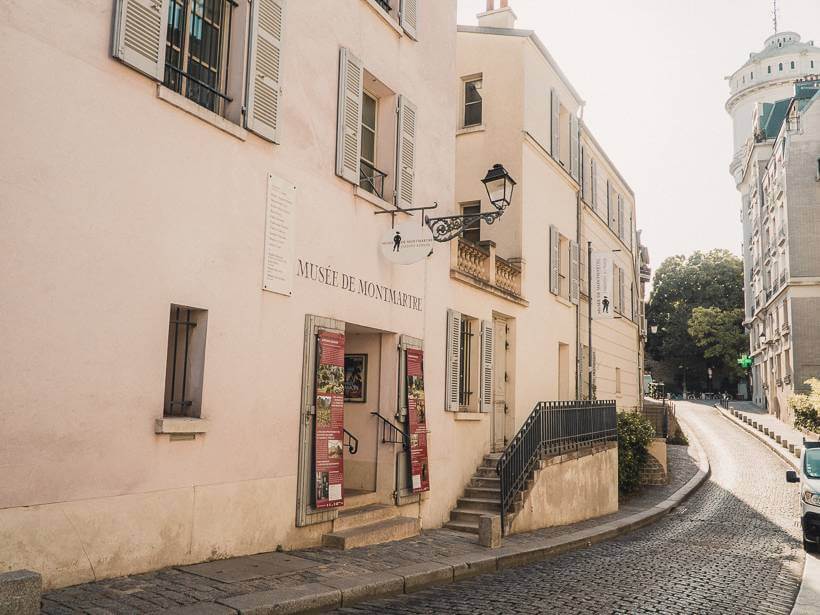
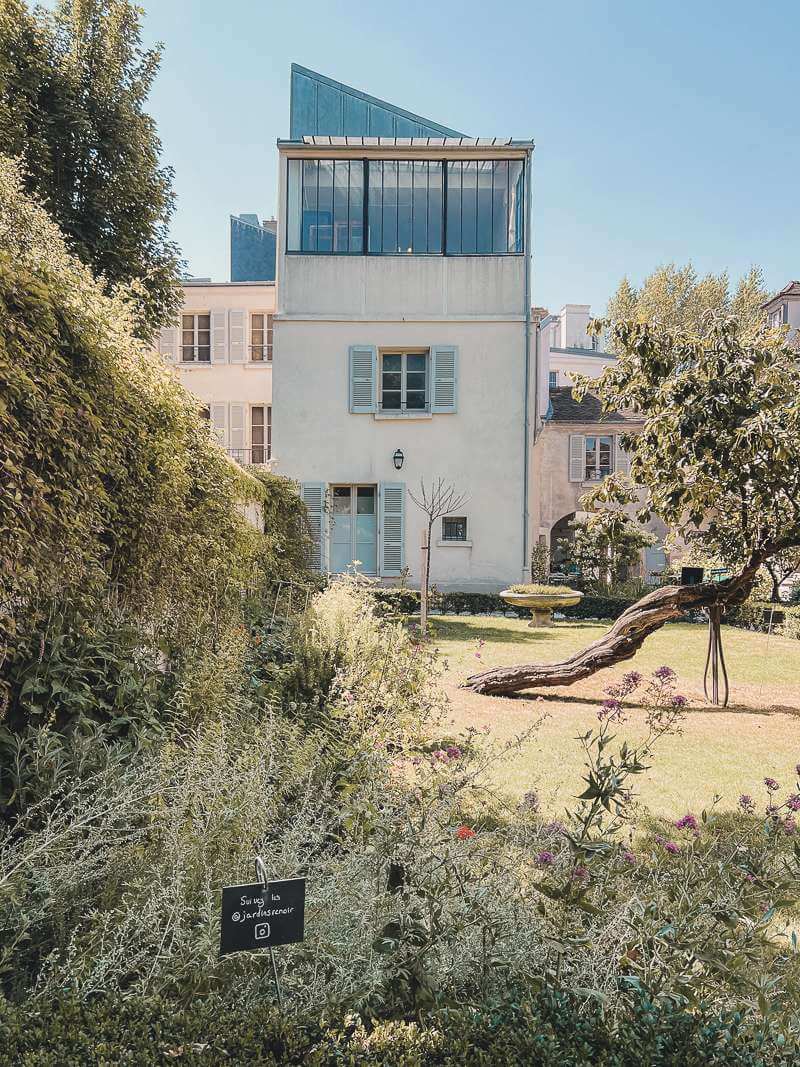
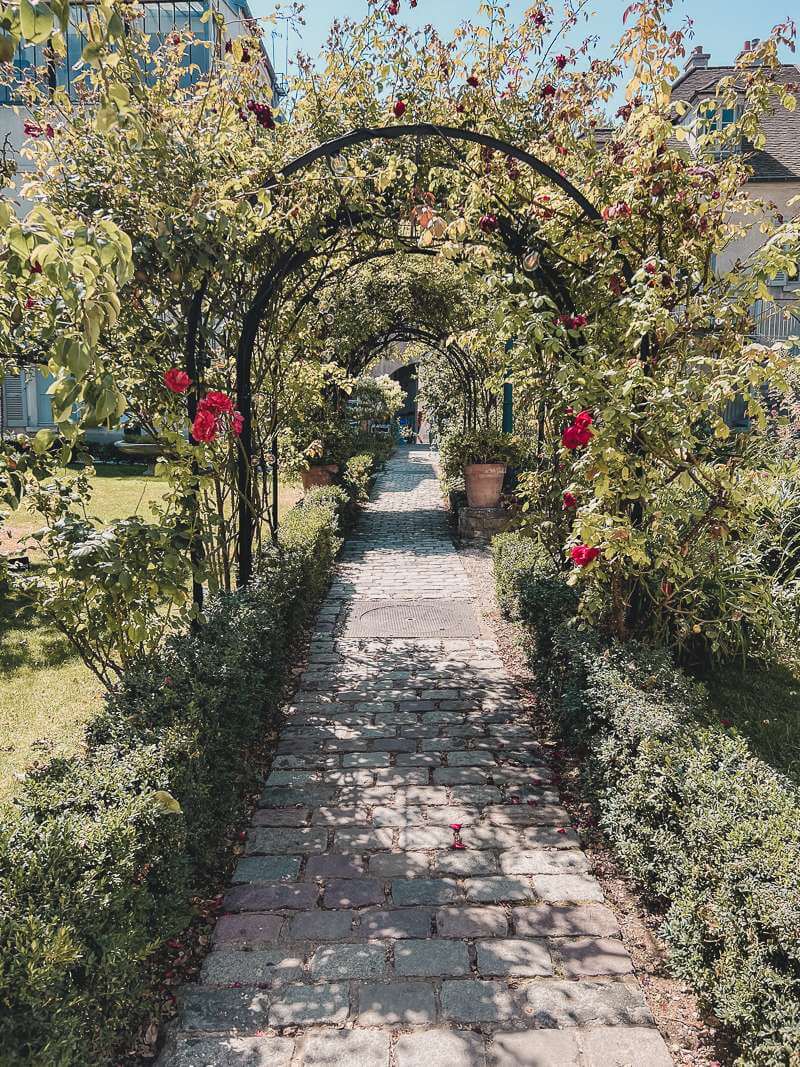
A walk through the Musée de Montmartre will have you entering the oldest building on the butte, which dates back to the 17th century. In 1960, addresses 12-14 Rue Cortot were converted into a museum to preserve crucial pieces of Montmartre’s history. It all honesty, many museums bore me, but not this one.
First off, some of the most famous Montmartre artists once called 12 Rue Cortot home. From 1875 to 1877, August Renoir lived here, and painted famous works like Bal du moulin de la Galette and Jardin de la rue Cortot. Later, in 1912, artists Suzanne Valadon, André Utter, and Maurice Utrillo also lived and found inspiration here.
Second, the museum’s exhibitions take you back in time to 19th and early 20th century Montmartre. Check out the detailed reproduction of Suzanne Valadon’s studio before browsing paintings, posters, and drawings by Montmartre artists. It’s impossible to leave here without feeling totally immersed into the bohemian Montmartre of yore!
Don’t forget to spend some time outside too, where there are three gardens that replicate Renoir paintings and a pleasant little café. Before continuing your Montmartre walk, head to the west side of the gardens to see this next fascinating sight.
Vigne du Clos Montmartre

Clos Montmartre is a hidden vineyard within the urban sprawl of Paris. It preserves the winemaking tradition that was a large part of Montmartre’s economy from at least the Middle Ages. By the time Montmartre became part of Paris in 1860, this practice had essentially vanished due to industrialization and diseased vines.
Artists living in Montmartre planted a new vineyard during the 1920’s in order to block a real estate project. Ever since the first harvest in 1933, there has been a festival each October to celebrate the grapes. The vineyard annually produces about 1,000 bottles of reportedly mediocre red wine each year, but it is still beloved for what it represents.
You can view Clos Montmartre by turning left onto Rue des Saules after you pass La Maison Rose. However, you will get an even better view from the gardens of Musée de Montmartre.
Just beyond the vineyard, you can also see the orange building of Lapin Agile. There has been a cabaret at this site since the mid-1800’s. It was a favorite hangout for artists to blow off steam, with one of the most famous clients being Pablo Picasso.
Rue du Chevalier de la Barre
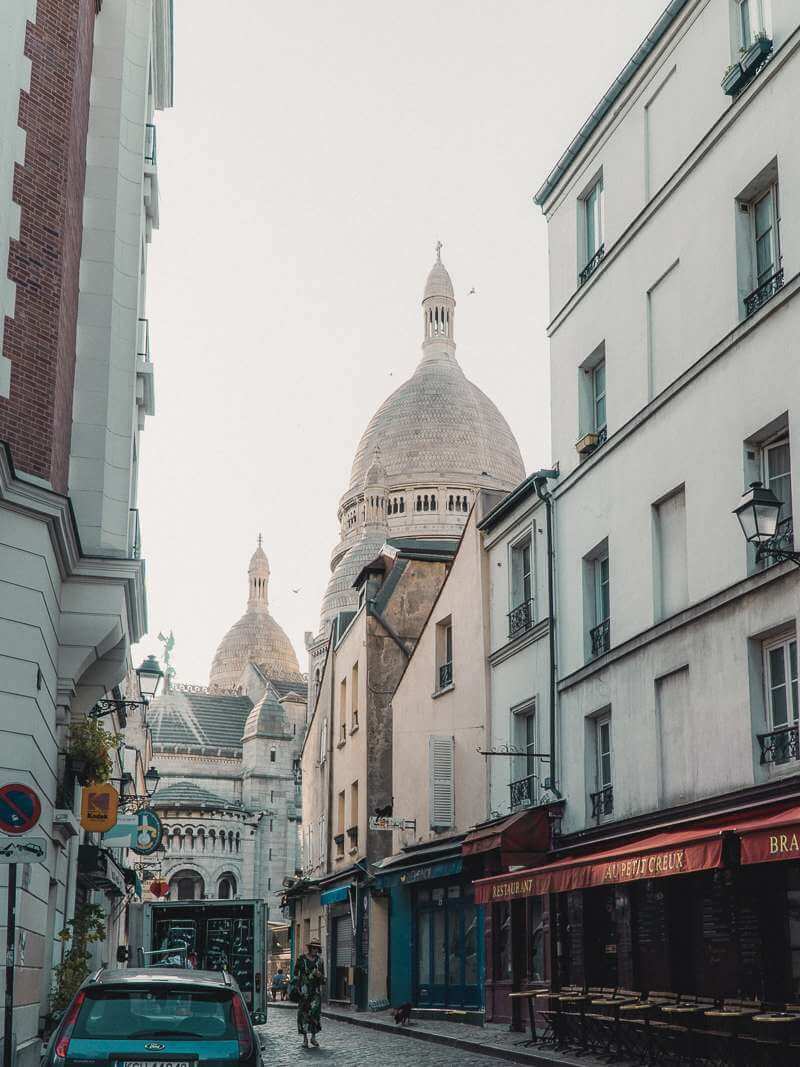
Feast your eyes on yet another beautiful street on this Montmartre walk. I found Rue du Chevalier de la Barre by accident after leaving the Musée de Montmartre, when I turned a corner and Boom! Stunning view of Sacré-Coeur right before my eyes.
This street is named for nobleman Francois-Jean de la Barre, who was brutally executed in 1766 for outwardly expressing religious intolerance. Some say his crime was not saluting a Roman Catholic religious procession, but there were probably other small offenses. This mattered at the time, as the church was very intertwined with government in Roman Catholic France, and La Barre’s actions were seen as blasphemous.
Today, you can find La Barre’s statue in Square Nadar. The 1897 original was melted down in 1941 during Nazi occupation, but was rebuilt and put in the same spot in 2001. La Barre’s statue and namesake street are seen to symbolize the checks that must be placed on religious power.
Today, Catholicism is still the predominant religion in France, although the country has actually become one of the least religious in Europe.
Sacré-Coeur
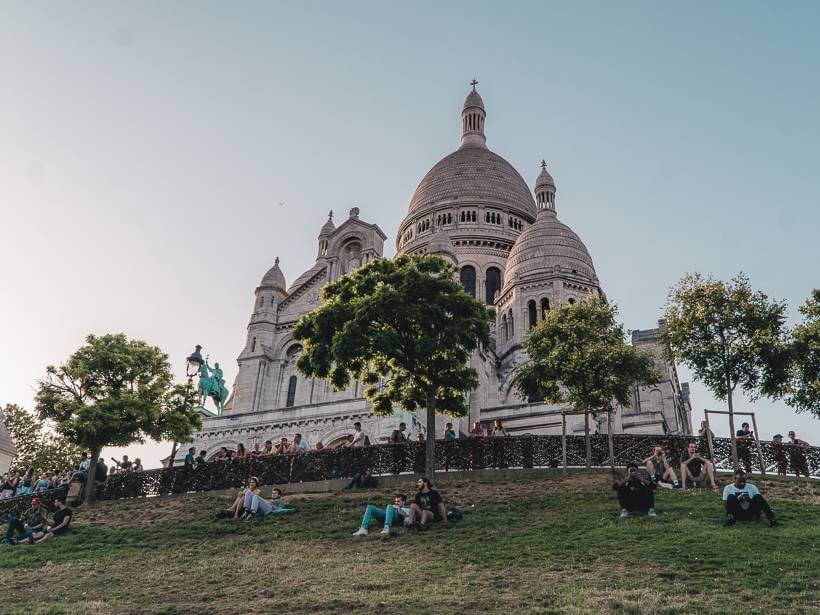
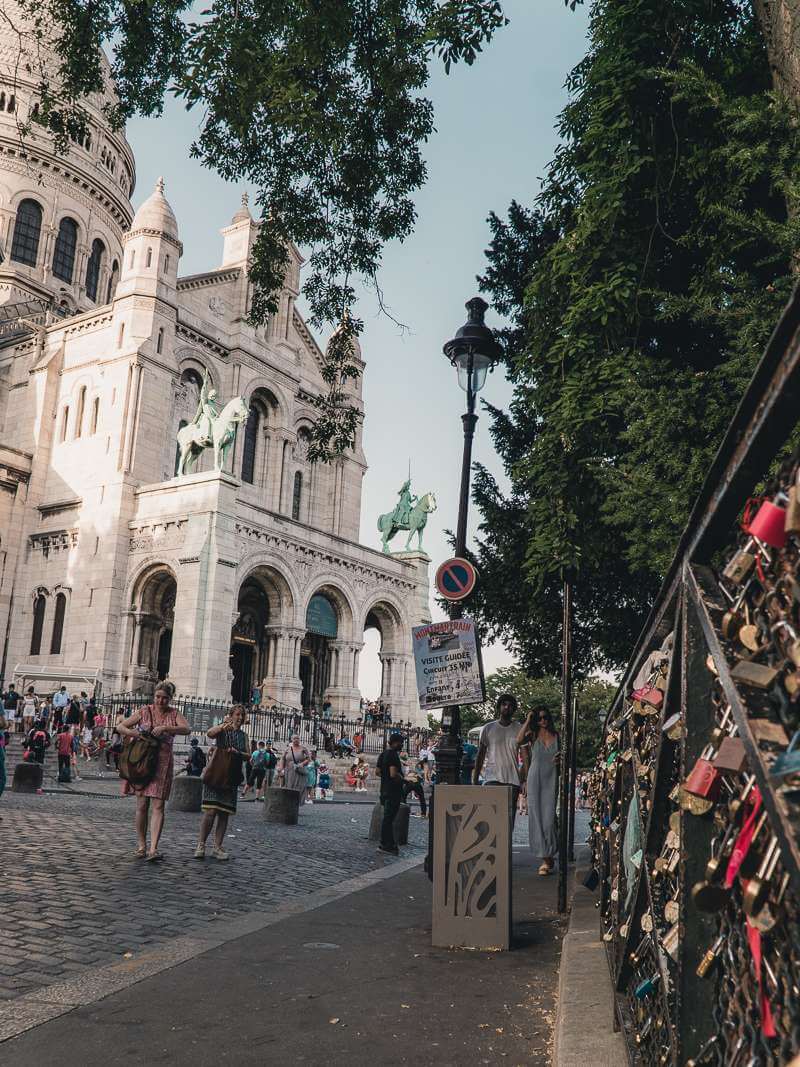
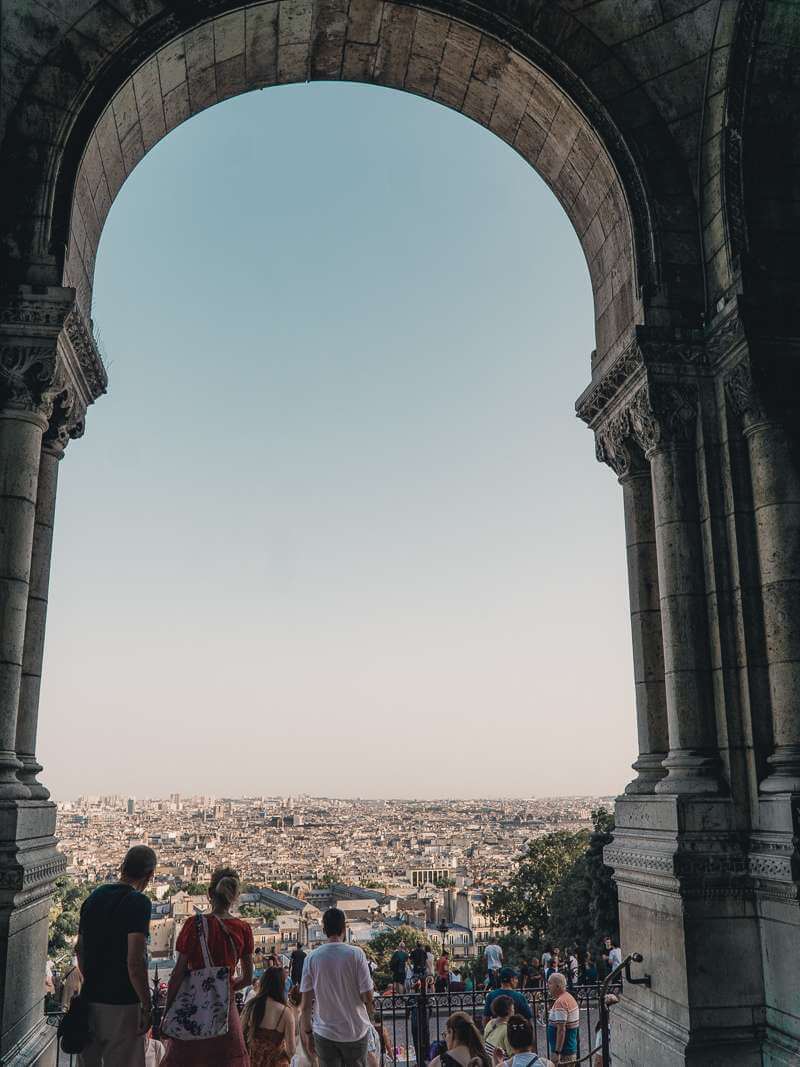
Sacré-Coeur is the star of Montmartre, drawing over 10 million visitors each year. It is situated at the top of the butte, which has been a site of worship since ancient times. One of the most famous legends is the martyrdom of St. Denis, who was beheaded here and walked off with his head still preaching.
Plans for Sacré-Coeur originated during France’s war with Prussia from 1870-1871, which fell during a century of national unrest. Some Catholics saw this violent period as punishment for increasingly immoral behavior in Paris. Upon losing the war, Hubert Rohault de Fleury and Alexandre Legentil pledged to build a new basilica high enough to be seen all over Paris to atone for the city’s sins.
At this time, Paris was split between the pro-monarchy Catholic establishment and increasingly liberal Parisians who desired a separation of church and state. This split culminated in the Paris Commune, an ugly period that saw destruction all over Paris and thousands of citizens killed. You could see why many Parisians would be weary of building what they saw as a giant symbol of Catholicism that would be visible from all over Paris.
Despite this, plans went ahead in 1873, when Architect Paul Abadie designed the new basilica in the Romanesque-Byzantine style. Funding for Sacré-Coeur came entirely from public donations, and despite a pause during World War I, was completed in 1923. The basilica’s iconic exterior is due to a type of limestone that releases calcite and becomes whiter when it touches rainwater.
Today, you can visit the basilica for free, as well as pay €7 to climb 300 steps to the dome, which gives panoramic views over all of Paris.
Sacré Coeur Steps

No Montmartre walk would be complete without a stop at the Sacré-Coeur steps. You can find them directly in front of the Basilica, with their incredible view over Paris’s rooftops, especially during golden hour.
Just stay aware of your surroundings while you take in this beauty. This area is infamous for pickpocketers.
“Sinking” House

The sinking house of Montmartre is a favorite photo spot for Instagrammers and bloggers. It is visible from Sacré-Coeur, to the left when facing away from the basilica.
To get a photo with the building seemingly “sinking” into the grass, you will need to go to the middle of the stairs in front of Sacré Coeur (not the ones attached to the building, but the next set below) and stand at the far left (facing Paris). Turn to the left, and you will be able to see the salmon-colored building sitting beyond a grassy hill.
Simply tilt your camera to the right, and voila! The building looks like it’s sinking. Note – you can also make the adjustment later, by turning the picture to the left during editing.
Place du Tertre

Located just steps away from Sacré-Coeur, Place du Tertre is lined with charming, albeit touristy, cafes and restaurants. The many artists who found inspiration here, including Van Gogh, Picasso, Pissarro, and Modigliani, led it to be called the “artists’ square”.
Translating to “of the mound”, Place du Tertre is Paris’s highest square and was Montmartre’s main gathering spot until the village became part of Paris in 1860. It was also the site of Montmartre’s first town hall in 1790. Three years later, the restaurant La Mère Catherine opened for business, and is still serving authentic French food today.
Montmartre’s creative spirit is kept alive in the center of the square, where artists with easels sketch portraits and paint scenery with watercolors. It’s good fun, but scams do happen, so agree to a price before sitting for a portrait.
Speaking of scams, Place du Tertre’s crowds of tourists tend to lure pick pockets. Visiting in the morning will help you avoid any unhappy situations and evade the worst of the crowds.
Join this food tour to eat your way through Montmartre
Rue Saint-Rustique

Continue your walk down Rue Saint-Rustique: the oldest street in Montmartre and the highest street in Paris at 130 meters. The street dates back to the Middle Ages, and received its current name after Montmartre’s annexation to Paris. The name comes from the priest, Rustique, who was executed alongside Saint Denis by the Romans during the spread of Christianity.
Utrillo famously painted Rue Saint-Rustique in 1926. Later, in 1973, it became the first street in Montmartre designated as a pedestrian walkway.
Today, Rue Saint-Rustique is an incredibly romantic alleyway to stroll, with gorgeous views of Sacré-Coeur. You will even pass a couple restaurant terraces charmingly tucked away along the route.
Montmartre’s current name may be derived from “Mons Martyrum”, which is Latin for “The Martyr’s Hill”.
Le Consulat Cafe

Le Consulat is a 19th century cafe that sits alone on the corner between Rue Norvins and Rue Saint-Rustique. The café is famous for the collection of celebrated artists that frequented it, which are rumored to include legends like Picasso, Sisley, Van Gogh, Toulouse-Lautrec, and Monet. Plus, it’s just adorable.
A perch here is a wonderful spot to watch the world go by while enjoying traditional French food and wine. Maybe you’ll even soak up some of the artistic energy that was once so prevalent in a bygone era.
Moulin de la Galette


The first thing you’ll undoubtedly notice about Moulin de la Galette is the giant windmill sitting on top. Being one of Montmartre’s last remaining windmills out of more than a dozen, it preserves an important part of this former village’s heritage. Don’t let the touristy appearance fool you, though – this restaurant is completely fabulous!
The famous “Radet” windmill above the restaurant dates back to 1717. In 1809, the Debray family purchased the windmill and used it to grind flour. With their flour, the family would make “galettes” to serve with milk to visiting Parisians, which later gave the restaurant its name.
During the 1830’s, milk was replaced with locally harvested wine and the mill became a cabaret. Renoir immortalized the venue in 1876 with his painting, Bal du moulin de la Galette. You can find a copy of the painting in the restaurant’s outdoor dining area today.
Thanks to new ownership in 2016, Moulin de la Galette’s restaurant lives up to its legendary status. The attentive waitstaff plays up the traditional French theme, with their short-sleeved striped shirts and flirtatious humor. Far from cheesy, though, the menu and atmosphere stay classic, while injecting a bright and playful feel.
I absolutely loved my sea bass and foie gras, and the mousse was a chocolate lover’s paradise. Complete it with a magnum of champagne for the ultimate celebratory evening! Be sure to make reservations for Moulin de la Galette in advance so you don’t miss out.
Moulin Rouge

The Moulin Rouge’s famous red windmill is one of the most iconic sights in Montmartre. You can find this cabaret at the foot of the butte on Place Blanche. The area is a little seedy, though not dangerous; however, there are certainly prettier areas in Montmartre.
The Moulin Rouge opened its doors on October 6, 1889, offering a dance floor, cabaret, and garden seating. Toulouse-Lautrec helped make this establishment famous with his posters and drawings, such as La Goulue. Moulin Rouge’s heyday was La Belle Époque, when visitors came to watch performances of the French cancan.
The original cabaret burnt down in 1915, but was rebuilt by 1921 with a copy of its original red windmill. Today, if you don’t mind some toplessness, you can still buy tickets to watch one of two nightly shows.
Truth be told, the Moulin Rouge is on a busy urban street, and there isn’t much ambiance during the day. I recommend returning for a show (purchase tickets here) to see the windmill lit up at night.
Montmartre Cemetery

Opened on January 1, 1825, Montmartre Cemetery (officially Cimitière du Nord), sits at the bottom of the butte. It has the unique characteristic of a metal bridge crossing overhead, as parts of this former quarry are below street level. Only people who died in Paris or had lived there can be buried here.
This hauntingly beautiful cemetery stands out for more than its collection of rather grand and intricate graves. Many of the writers, composers, singers, painters, etc. who worked on their craft in Montmartre are buried here.
One of the most visited graves is that of Dalida. However, you can also find author Alexandre Dumas fils, son of Alexandre Dumas who wrote novels like The Count of Monte Cristo, and Adolphe Sax, who invented the Saxophone. The elder Dumas is buried in the Panthéon.
As a writing and photography enthusiast myself, it was moving to see the resting spots of so many creators and thinkers.
Suggested Stay Near this Montmartre Walk
I loved my hotel room at Hôtel Monterosa – Astotel. This 9th arrondissement hotel had breakfast and a cute street view in a much less touristy area than Montmartre. I was still near plenty of local eateries, and only had to walk ten minutes to the Wall of Love.
• • •
There you have it! This walk is proof that Montmartre is the most charming and gorgeous part of Paris. Its unique history will have you buzzing with inspiration after discovering new layers of Paris’s culture. Plus, your camera will be full of frameable beauties.


